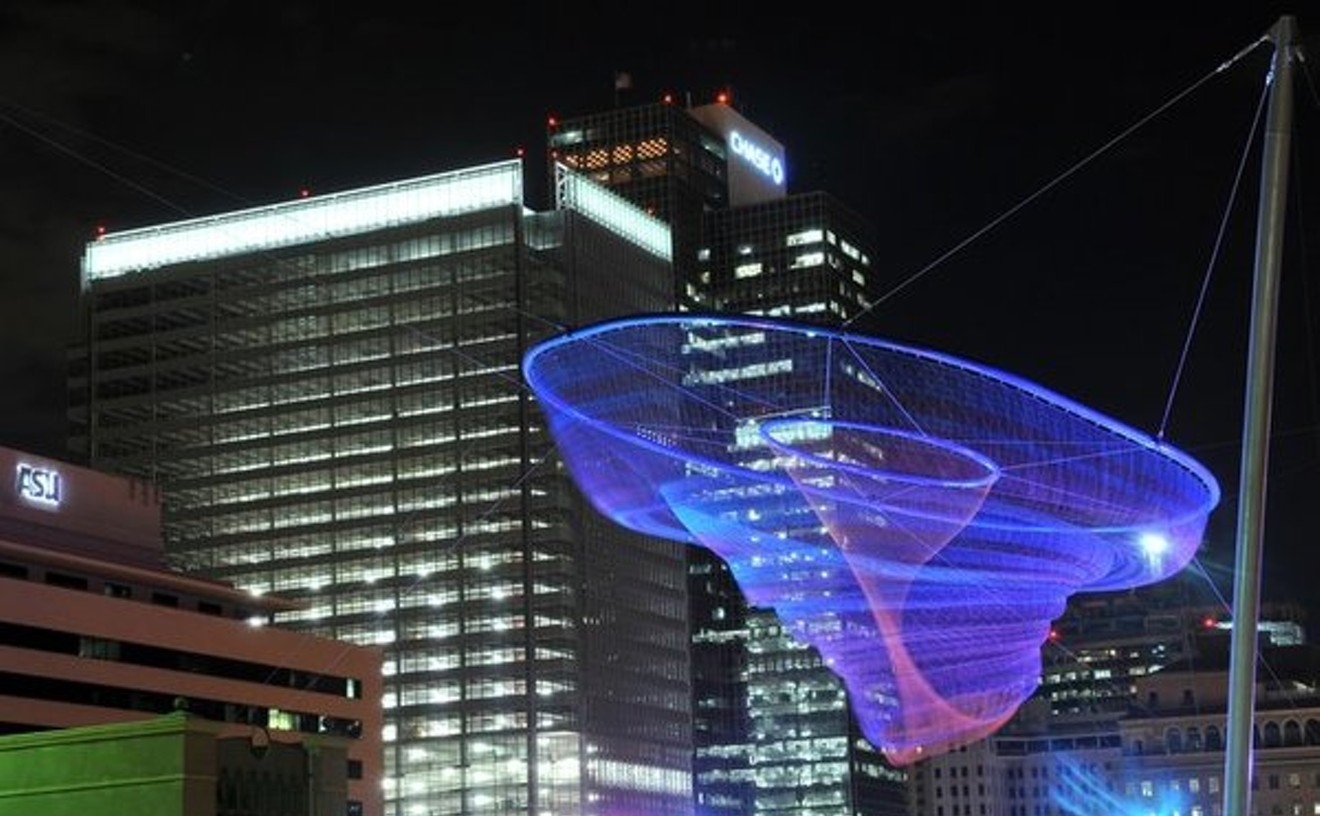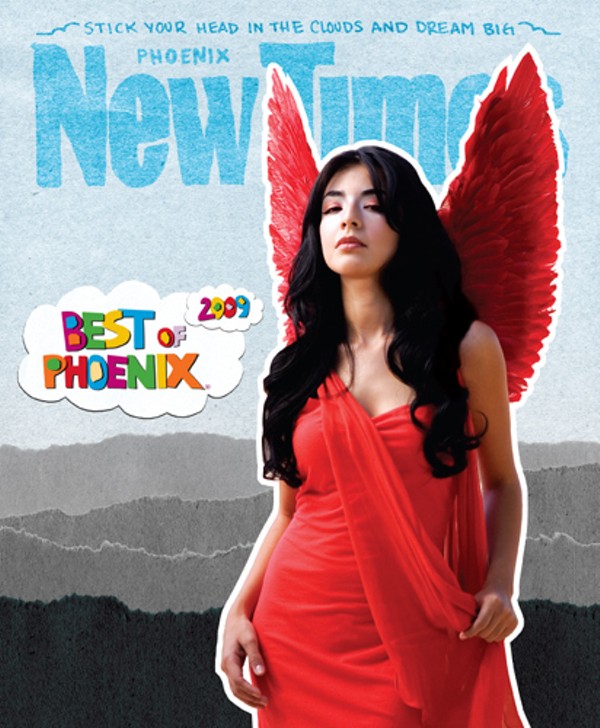In many ways, The Cover Up are local label Modern Art Records' forgotten band: the hardcore counterpart to indie faves like Miniature Tigers and Back Ted N-Ted. But they do have one distinction none of their peers will likely ever equal, having been featured in a commercial commissioned by Commonwealth Bank of Australia. Their bit was part of a series of commercials that featured a clueless American advertising agency pitching ideas to levelheaded but open-minded Australian bankers, who politely dismiss their foolhardy ideas. In their installment, The Cover Up are playing their brand of melodic hardcore in the middle of a typical bank branch while Aussie businessfolk mill about, trying to ignore them. "Your new debit MasterCard offer rocks, so we thought your bank should rock," one of the ad execs says to a confused Australian. "Hold up guys . . . Do they know anything a little more mellow?" the Aussie asks. "Of course. Play the love song," the ad exec says. The band, predictably, picks up right where they left off, and hilarity ensues.
Best 'Zine
hoozdo
For the second year in a row, hoozdo knocks the socks off any Phoenician able to get an issue in his or her lucky little paws. Equal parts celebration of the urban boom that we're on the cusp of and lamentation of the life of Phoenix natives being lost in supermarkets and strip malls, hoozdo brings them together in a gleefully uneasy union that seems perfect for our fair city. The photographs and glossy paper are a welcome step up from the Xerox jobs of other 'zines (love them as we do), while the content is eclectic and well written. Lately, hoozdo has dabbled beyond print, with a blog, Twitter account, and bundled CDs of local music, but the heart of the 'zine is as a wonderfully gawky paper version that pops up periodically at our favorite haunts around Phoenix.
Best Web Comic
Monster Commute
For many Valley suburbanites, there's truly no greater torture than the daily commute. Besides all the anger-inducing congestion, there always seem to be annoying X-factors that make the commute even worse: idiotic drivers and even more idiotic cops, not to mention all the obnoxious drive-time DJs. So how does one cope? Peoria graphic artist Daniel M. Davis and his wife, Dawna (who both endure a three-hour drive every workday), use their daily Web comic Monster Commute to vent automotive aggravations. Described as a "traffic novel," it involves the characters of robot Chadworth Machine and the demon-like Beastio traveling in an endless rush hour through the netherworld. Daniel creates the comic on his iMac with Adobe Illustrator and utilizes a macabre pop-art style (which resemble the works of Mike Maas) mixed with steampunk and retro-futurism. There's a small-but-growing fan base, which seems to get bigger by the day. Misery loves company, we guess.
Best Comic Relief
"Arizona State Snubs Obama" on The Daily Show
If only Michael Crow had eaten some namesake fowl and backed down from his mighty institution's boneheaded decision not to give President Barack Obama an honorary sheepskin. It would have been so simple. And it would have spared ASU from being the butt of endless jokes and the object of scorn and derision on The Daily Show, which famously called ASU "the Harvard of date rape."
There's wicked karma involved here. Crow has earned a rep as dictatorial and moralistic, forcing upon the party school a wishful paradigm of abstemiousness and academics, while going to war against the fraternities and their Animal House ways. Dean Wormer-like, he put his foot down.
Now everything Crow's strived for has been undone, and ASU will be remembered as the place that refused to grant the nation's first black president a worthless piece of paper because it didn't deem him worthy. At least the country got to see what we put up with. And we all got a good laugh over it.
Best Snowman in July
July 28, 2009
There's just not enough whimsy here in Phoenix, particularly in the summer, so we took note (and a picture) when — on one of the hottest days of the year — we saw a snowman.
It was 7:30 a.m., and there he stood, just outside the door of our favorite coffee shop. Melting.
He was about as tall as a kindergartner, equipped with the requisite coal eyes, carrot nose, twig arms. No one was around to claim him, and we couldn't guess where someone got that much ice, let alone the will to attempt such a pointless task.
But we thought about that snowman all day, and smiled. That night, on our way home, we swung by to see what was left of the little guy. Just the coal and carrots — and a wet spot — but we put our hands on the ground where the snowman had been, and miraculously, all those hours later, the concrete was still cold.
We still don't know who made him, but we hope that whoever built the snowman knows that he or she made our 115-degree day.
Best Graffiti
Behind La Piñata
to the city hotline to get it covered up as quickly as the next guy. But all graffiti isn't vandalism. Sometimes, it's art. And, oddly enough, the best example of graffiti art in town isn't stretched out in public. In an alley behind La Piñata, the Mexican restaurant on 19th Avenue just north of Osborn Road, is our Louvre of mural-based graffiti. Unlike some spots where graffiti is thrown up without permission, here the work is encouraged by the local businesses, and the paint donated by Montana Spanish Paints. Nearly 100 feet of urban landscape, including aliens, weirdos, flaming hubcaps, burning motorcycles, purple people, and an impressively large color block pattern almost 20 feet high, lines the back of the little strip mall. Instead of bland, boring, and illegal, these vivid murals, although hidden, are reminders that all graffiti isn't vandalism. A little permission, a little paint, and a little skill make all the difference.
It became difficult to understand how robots could be portrayed in science fiction as threats after seeing Atticus Fraley's installation. The "Bell'e Art" series, presented by Scottsdale Public Art, rotates art in the Scottsdale Civic Center Bell Tower. We haven't loved every project (frankly, the bubble fountain was disappointing and smelled bad), but we were delighted in early 2009 when an onslaught of flying robots filled the space. Fraley used vintage recycled objects — like U-shaped magnets for hands, industrial light bulbs for heads, thermoses for legs and picnic jugs for bellies. These little guys were soaring, parachuting, and coptering in for an adorable onslaught. At night, with their lightbulb heads aglow, all of Scottsdale welcomed this invasion. We were sorry to see the robots go, but last time we checked, Orange Table — the groovy coffee house adjacent to the art space — was memorializing them on T-shirts.
Best Castle
Tovrea Castle

Like so many things in Phoenix, Tovrea Castle isn't what it appears to be at all. This peculiar, turreted house, built in 1928 in what was then literally the middle of nowhere at 50th Street and Van Buren, looks more like an attraction at a miniature golf course than a building inspired by the homes of Italian noblemen. Seen from eastbound Loop 202, Tovrea (pronounced Toe-vree) is a flag-topped, dome-roofed faux castle in the middle of the Southwest desert, a kitschy reminder that Phoenix was once even weirder than it is today, and a testimony to the fact that the city's inability to finish anything isn't a new trend.
The castle and its surrounding Carraro Cactus Garden were built by Italian immigrant Alessio Carraro, a San Franciscan who'd hatched a plan to create his own resort town on 277 acres of creosoted desert just east of the Phoenix city limits. He intended to build a resort castle surrounded by dense acres of vegetation, and between 1928 and 1930, he and a crew of two dozen workers overhauled the barren landscape into a colossal cactus garden, designed by a Russian gardener named Moktachev and wrapped around a magnificent wedding cake of a house meant to be the crowning jewel of a privately owned housing development that never came to be.
Instead, we're left with a pretend castle, five separate gardens, various outbuildings, and some goofball water features that — because the City of Phoenix purchased the castle and the 36 acres of land surrounding it in 1993 — local Tovrea fans and tourists alike can enjoy during the castle's twice-monthly garden tours. Every penny of the $15 admission price goes toward upkeep of the recently restored castle and grounds, which you can see for yourself by reserving a spot on its next tour on the castle's Web site.
- 5041 E. Van Buren St., Phoenix, 85008 Map
- 602-256-3220
- www.phoenix.gov/PARKS/tovrea.html
Best Public Art
Her Secret Is Patience by Janet Echelman

No pun intended, but it's a wonder that Her Secret Is Patience, a massive sculptural installation by Boston artist Janet Echelman that now anchors downtown's new Civic Space Park, ever got built to begin with. Inspired by Arizona's monolithic monsoon clouds and the fleeting flowers of the state's iconic saguaro cactus, Echelman's ethereal creation of free-floating netting and steel, which changes with the wind and is kaleidoscopically uplighted at night, almost never got built — thanks to a city government faction that wanted to dump the project mid-stream. But public support and the commitment of the Phoenix City Council ultimately won out. The sculpture, which had been dissed as resembling everything from a jellyfish and collapsed sphincter to a thought balloon and cowpie, is now the eye-popping focal point of the city's newly opened downtown park across the street from ASU's Walter Cronkite School of Journalism. More impressive against a nighttime sky than its daytime backdrop, Her Secret Is Patience hypnotically draws people in like moths being sucked into a multi-colored, ever-changing flame.
The name of Echelman's massive sculpture is unforgivingly appropriate. It comes from a quote penned by Ralph Waldo Emerson, 19th-century American Trancendentalist poet, philosopher, and essayist: "Adopt the pace of nature; her secret is patience." Emerson is the same guy who once wrote, "To map out a course of action and follow it to an end requires courage." And courage is what it took to get Echelman's artwork up and butting against the sky.
- 424 N. Central Ave., Phoenix, 85004 Map
- www.phoenix.gov/parks/index.html
Best Performance Art
"Angela Ellsworth: Underpinnings"
Phoenix multi-media artist Angela Ellsworth is always coming up with brand-new ways of making salient points about art, life, culture, societal mores, and just plain stuff. She scored again, big-time, with an eminently memorable live piece performed January 8 in conjunction with her exhibition, "Angela Ellsworth: Underpinnings," at Lisa Sette Gallery.
As a tribute to pioneering female performance artists of the 1960s, '70s, and '80s, Ellsworth dressed rosy-cheeked young ladies, outfitted like "sister wives" of the infamously polygamous Fundamentalist Church of Latter-day Saints, in missionary-style, Mother Hubbard muumuus, frontal hair poufs, long, fake braids, and running shoes. In slow motion, they roamed the gallery that evening, silently miming past performance art while armed with objects — a machine gun, a rag stuffed in a mouth, a flashlight — used in the older, still-controversial works. The flashlight was used to illuminate the crotch of another, reminiscent of Annie Sprinkles' 1989 Public Cervix Announcement, during which the hooker/stripper/porn star turned feminist performance artist invited people to celebrate the female body by using a flashlight and speculum to see her cervix.
God only knows what people passing the gallery during this scenario thought when they got a gander at the goings-on, but it was fun to speculate. We don't think Scottsdale will ever be the same.





